The 2018 Apple iPad Pro (11-Inch) Review: Doubling Down On Performance
by Brett Howse & Andrei Frumusanu on December 4, 2018 10:00 AM ESTGPU Performance
Apple’s custom GPU in the iPad Pro is the same one found in the iPhone, but with more cores available. And with the larger surface area of the iPad compared to the phone, likely a higher frequency as well. There’s now seven of the A12 GPU cores, compared to just four on the iPhone, and Apple claims the GPU in the iPad Pro is equivalent to an Xbox One S, although how they came to thise conclusion is difficult to say since we know so little about the underpinnings of the GPU.
In rough terms, the Xbox One S is roughly 1.4 TFLOPS at its peak. But for better or worse, when the PC moved to unified shaders, the industry moved to FP32 for all GPU functions. This is as oppposed to the mobile world, where power is an absolute factor for everything, Vertex shaders are typically 32bpc while Pixel and Compute shaders can often be 16bpc. We’ve seen some movement on the PC side to use half-precision GPUs for compute, but for gaming, that’s not currently the case.
Overall, that makes like-for-like PC comparisons difficult. An AMD Ryzen 2700U SoC has a Vega GPU which offers 1.66 TFLOPS of FP32 performance, in theory. If run at 16-bit, that number would double, in theory. The iPad Pro would likely use half-precision for some of the GPU workload. This has been an issue for years and has made it difficult easily compare any cross-platform benchmark against the PC.
As with the iPhone, Apple’s peak GPU performance, even in the iPad, is still significantly higher than sustained performance. Please check out our iPhone XS review for Andrei’s deeper dive into this, but thanks to GPU compute transactional workloads in iOS, having high peak performance is a benefit even if it can’t be sustained over time.
3DMark Sling Shot 3.1 Extreme Unlimited

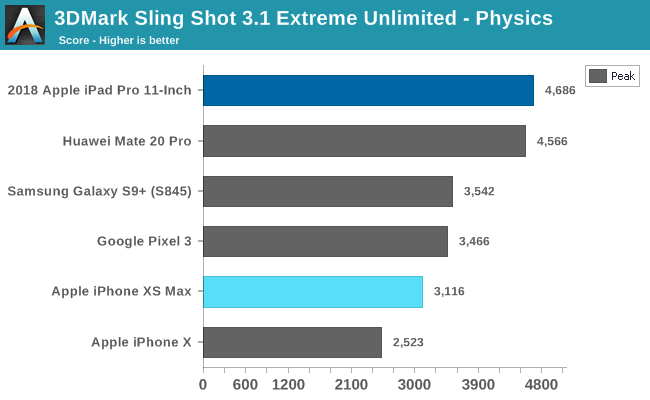
Here is our first look at the GPU in the iPad Pro compared to the mobile competition. Despite having only 75% more GPU cores than the iPhone XS Max, the iPad Pro scores 164% higher in the graphics result, which will be down to the clockspeed of the GPU and increased memory bandwidth. It is well ahead of everything else in the mobile world.
In the Physics result, which is more of a CPU test, the iPad Pro is still the highest result, but gap to the competition is much lower.
Also of note is that this benchmark is extremely unreliable on the iPad, crashing most of the times it is run.
3DMark Ice Storm Unlimited
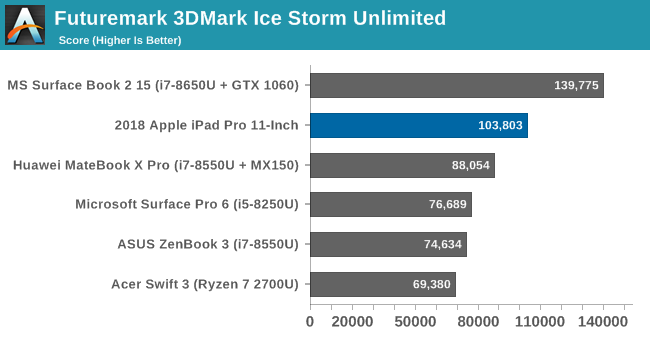
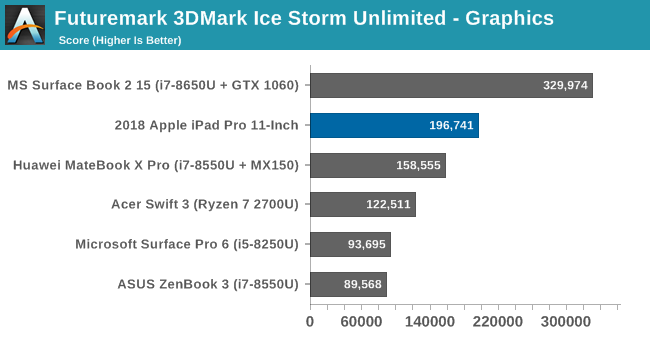
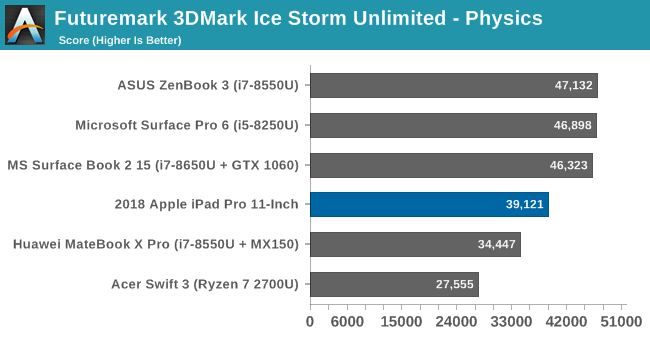
Here is the first test we can use to compare against the PC, but unlike Sling Shot which uses Metal on iOS, this test relies on OpenGL ES 2.0. On Windows, it uses DX11, and of course the precision is not the same across mobile and PC with the PC version running at 32-bit and OpenGL ES 2.0 only using 16-bit.
Overall, the iPad Pro is well ahead of any of the PCs in this test, although the Physics test does show that the latest Intel CPUs still hold an edge over the iPad in this test. On the graphics side though, the iPad Pro scores over double the AMD Ryzen 7 2700U with Vega, and unsurprisingly Intel’s UHD 620 GPU brings up the rear.
GFXBench
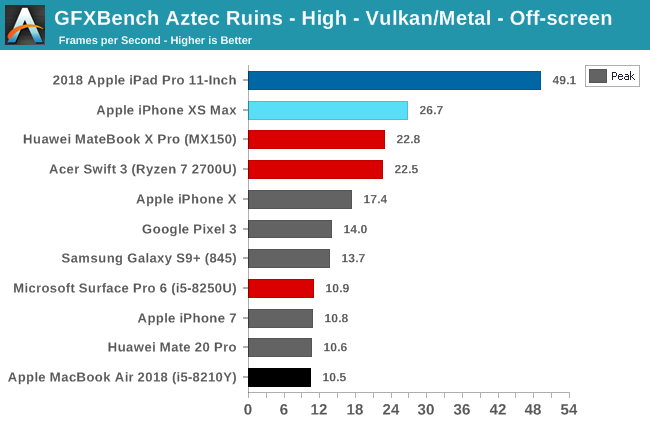
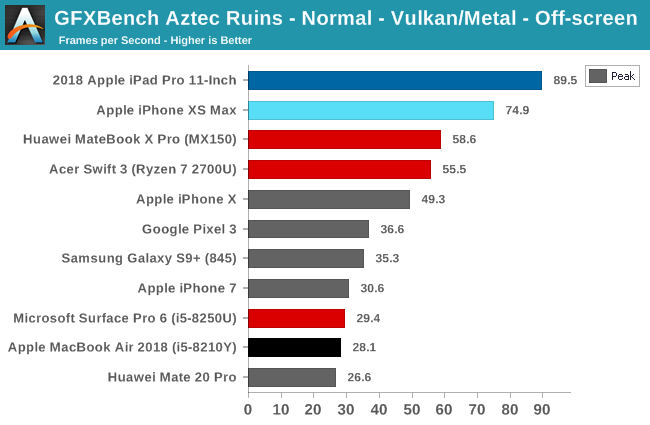
The latest test from GFXBench is Aztec Ruins which offers both a normal mode in 1920x1080 resolution, as well as a high mode which is run at 2560x1440. It is quite a bit more complex than their older tests, and Kishonti has created the test in all of the modern API: Vulkan, Metal, and OpenGL ES 3.2 for mobile, and on the desktop it is available in OpenGL, DX11, and DX12. For our purposes, we’ll disregard OpenGL on the desktop since it is well on its way out at this point.
Peak performance of the iPad Pro is far above any of the 15-Watt laptops we tested. We’re unsure right now if the Metal version uses half-precision shaders, but Kishonti's old benchmarks did, so it likely is here as well. The gap compared to the iPhone isn’t huge though at the Normal settings, indicating that the benchmark is getting CPU bottlenecked at low resolutions. The High settings show an 80% increase in performance with the iPad compared to the iPhone XS.
Sustained Results
As hinted to above, Apple offers significantly more peak performance from the GPU than sustained, which can be beneficial for computational GPU in the OS for various functions. But for gaming, sustained performance is important.
GFXBench offers a battery rundown mode where Manhattan 3.1 is looped consecutively. For a comparative basis, if you run Manhattan 3.1 on the iPad the result is 100.79 frames per second on a single run, which is 6249 frames.
The longer test starts out high, but then decreases in performance significantly in the first couple of runs, and then starts to taper off near the end. The lowest framerate in this roughly 30-minute test is 3960.9 frames, which works out to 63.9 frames per second. That’s about a 36% decrease in performance over time.
Gaming results
All of these synthetics have a place but actual gaming is what people want extra performance for. When Apple states that the iPad Pro has an Xbox One S class GPU, that means in games, because you don’t use an Xbox One S to do transactional compute workloads.
All of the above caveats apply though, and it’s compounded by there being almost no cross-platform games available on both the PC and iPad. One exception to this rule is Civilization VI, which now offers pretty much a full port of the PC version on iPad.
On the iPad, Civilization VI is configured to use Metal, compared to either DX11 or DX12 on the PC. As an iPad app though, there are far fewer configuration options in iOS, but with the right tools you can access the configuration text file and make a few changes.
By default, the game on iOS runs at just a 1112x834 resolution – the non-retina resolution of the last-generation 10.5-inch iPad Pro – and there’s no way to customize the graphics through the UI like there is in the PC version of the game. You can edit the config file to unlock the Retina version of that resolution though, which doubles the effective resolution to 2224x1668. Also, because the game is a port of the PC version, you can also access the debug menu to get a look at the frame times.
We loaded up the same save game file on all devices, and the same configuration file on multiple devices, with the game resolution within 1% of the iPad, and then checked out the frame times for each:
At stock settings on the iPad, the GPU had no issues capping out the frame rate at the 27 Frames per second maximum.
Doubling the resolution of Civilization VI had literally no impact on performance. The iPad Pro can run at 2224x1668 easily framerate limited to the same 27 FPS of the non-Retina version of the game.
Intel’s UHD 620 paired with the Core i5 in the Surface Pro 6 is not framerate limited, but it is GPU bound, at just over 21 FPS.
The GeForce MX150 in the Huawei MateBook X Pro is the lower TDP version of the MX150, capping at around 1038 MHz. It’s able to achieve 45 FPS consistently.

Our last device features the AMD Ryzen 7 2700U, which has 10 Vega Compute Units in a 15-Watt TDP. It offers the highest performance at these settings, with almost 50 FPS average.
The results from Civilization VI is more or less the entire iPad Pro experience in a nutshell. The A12X SoC has ample performance, but the limitations of the implementation of this game on iOS limits what the user can achieve. With a frame lock of roughly 27 frames per second, the iPad Pro has no issues at all maxing that out at all times, and the benefit of a frame rate limiter is that the amount of power required is much lower, and therefore the battery life is better. But unlike the PC there is really no way to get around this limitation. Civilization VI isn’t the kind of game that needs really high framerates to be playable, but it is rarely up to the user as to what they can do on iOS. The game was clearly ported to ensure consistent performance on the earlier models of iPad, and when Apple drops a much faster GPU in the iPad, there’s no way to adjust the performance to take advantage of it.
GPU Conclusion
So is the iPad Pro an Xbox One S class of GPU? Likely it is. The Xbox One S is only slightly quicker than the original Xbox One launched in 2013, and that console would struggle to achieve 1080p in games of that vintage. The Vega iGPU in the Ryzen 7 2700U offers more theoretical FLOPS than the Xbox One S, although at a higher TDP of 15-Watts, compared to the iPad Pro. In the synthetic tests, the iPad Pro scored higher than the Vega GPU, albeit at a lower precision, but regardless, there’s little doubt that the GPU in the iPad Pro is quite powerful. Add in the efficiency and the lower TDP, and results are even stronger. On the sustained performance run, the iPad was averaging just under 8 Watts of draw for the entire device.


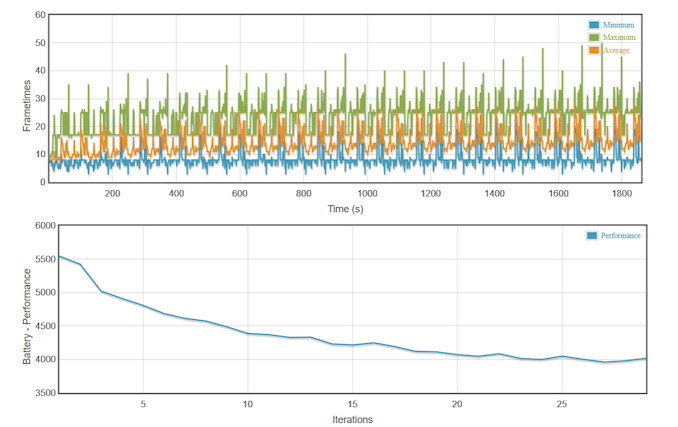



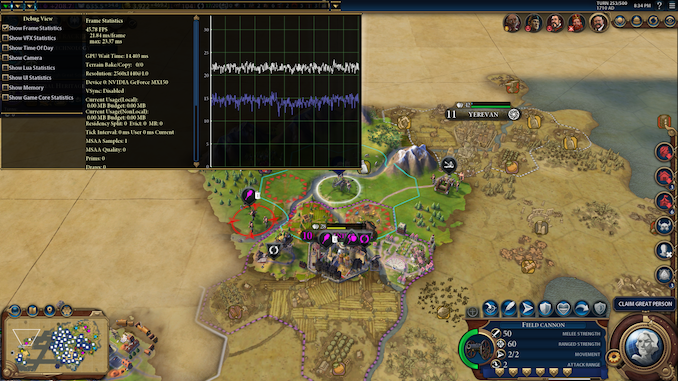








145 Comments
View All Comments
jeremyshaw - Tuesday, December 4, 2018 - link
Crikey, that's a fast chip.That question about the xbox one s class GPU does raise questions. Why does the Xbox One S draw so much power?
axfelix - Tuesday, December 4, 2018 - link
Because it's still using an AMD GPU architecture from 2013, and Apple's and Nvidia's architectures are >3x as powerful per watt at this point.PeachNCream - Tuesday, December 4, 2018 - link
Eh, NV is just as bad. Their current gen products (GT 1030 aside) generally need more than 75W of power and occupy space equal to two PCI-E slots.Pyrate2142 - Tuesday, December 4, 2018 - link
Yeah, but those 75W and above cards are operating at a significantly higher performance. You cannot really compare it straight like rust, because 1- not only is the NV cards doing full FP32 compute compared to mixed FP16 and FP32 on the iPad, meaning it is inherently a more strenuous workload to begin with. 2- performance scaling is not a linear functionIn short we can't really take those claims at face value because A- we don't have a way to measure and compare performance in the first place (which brings me to the question of how is apple actually comparing? Using TFLOP performance? Because TFLOP is not an accurate way of measuring GPU performance as a GPU has to do more than just FLOP. Take a RX580 at almost 7 TFLOP and a similar GTX1060 6GB at 4.5TFLOP in FP32. The TFLOP difference suggests a huge performance differences butcher they both perform similarly.) and B- again NV doesn't really make cards that scale down to what the iPad is having. In short, best case it's truly an apples to oranges comparison and I don't think you can directly translate that GPU in the A12X performance against AND or NV because it just not the same comparison both in power target of even how the performance is measured
Spunjji - Wednesday, December 5, 2018 - link
Just responding firstly to endorse your comment, and secondly to note that Nvidia do make something at that scale - the 256 CUDA-core Pascal GPU in Tegra X2 would be a solid point of comparison, were it not basically impossible to perform one.olde94 - Wednesday, December 5, 2018 - link
For power/performance i have a few inputs.When looking at Nvidia jetsons running X2 and X1 most performance improvement are on the CPU side of things.
Also for power refference. The Nvidia shield is not a portable device, and the nintendo switch, running the older version of the 256 cuda core SoC have the GPU running at 764mhz in docked mode and 324 in handheld. The reason is a combination of the battery and the active 30mm fan + somewhat heatsink, cooling solution. The charger is 40W charger, and while it does charge the battery, i will assure you no more than 15W is used for this, and based on charging time during full load, it's less than 10W. Note also that the screen is NOT on.
An nvidia TX2 is rated at ~20W if i recall, making it WAY more power hungy than the A12 chip
PeachNCream - Thursday, December 6, 2018 - link
Eh, the A12X puts a lot into perspective when it comes to compute performance. The big three players in the x86 CPU and GPU space are chasing performance at a cost of rising TDP, at least the phone and tablet competition is highly constrained by power and thermal limits inherent to the platform. The result is that the technological improvements we see in those highly mobile products generally focus on both power and performance. Its a pity to see stupid dual slot coolers on graphics cards to that have to cope with TDPs that range from 75 to an absolutely irrational 200+ watts and processors that blow their TDP budget by 50% under load. I had a Packard Bell 386 PC that was happy with a 60W internal power supply. Computers in 2018 are stupid. They shouldn't even need cooling fans at this point or heatsinks. That old Packard Bell ran a bare IC without even so much as a piece of metal glued atop it and under load, you could rest your thumb on the CPU and it would feel warm, but not hot to the touch.Oliseo - Thursday, January 2, 2020 - link
That old packard bell was orders of magnitude slower than modern CPU/GPU's and was orders of magnitude less effecient than modern CPU/GPU's.Even if you normalised for cooling requirements.
This doesn't make modern CPU's/GPU's stupid, you know what it does make stupid tho....
tipoo - Tuesday, December 4, 2018 - link
It's several fabrication node shrinks back (28nm vs 7nm) and on a 2013 architecture.You could probably get something close-ish to XBO performance in a handheld Xbox on 7nm, that would be an interesting product if it had full compatibility...
axfelix - Tuesday, December 4, 2018 - link
The Xbox One S (which I think is the comparison here) is actually on 16nm, though it's still that 2013 architecture. I think Apple gets about 2/3 of the advantage from the architecture and 1/3 from the process, and it does work out still to >3x efficiency.